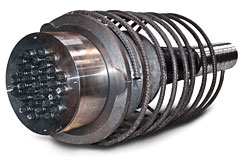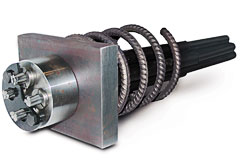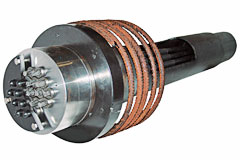![[Translate to en-CH:]](/fileadmin/con-bbv/BBV_Titelbilder/BBV_6_REV1835.jpg)
The right partner for your prestressing work
Strand post-tensioning systems
We have technical approvals for internal and external prestressing systems and the necessary expertise to carry out prestressing work.
European and nationally approved
With the adoption of ETAG 013 (Guideline for European Technical Approval of Kits for Prestressing of Structures) in June 2002, the required scope of testing for tensioning methods was redefined throughout Europe. Our systems are approved at European and national level in accordance with these test guidelines.
Our post-tensioning systems with general technical approval or with European approval and general type approval can be used for structures within the scope of DIN EN 1992-1-1 in conjunction with DIN EN 1992-1-1/NA or in accordance with DIN EN 1992-2 in conjunction with DIN EN 1992-2/NA.
BBV tensioning method with subsequent bonding, type i

The internal post-tensioning method with subsequent bonding is designed for the use of prestressing wire strands of grade St 1660/1860. Prestressing wire strands with a nominal cross-sectional area of 140 mm² or 150 mm² are used for the tendons. The tendons are either delivered directly to the construction site in bundles of 3 to 31 strands as prefabricated tendons or manufactured on site. The following construction elements are available for the tendon types:
- Spanning couplers (fixed/movable)
- Single strand couplers
- Bond anchor L4
- Loop anchors L3 to L22
- Oval ducts L3 to L7
Our anchorages and couplers are also available electrically insulated, tested and approved in accordance with Swiss standard SIA 262/1, corrosion protection category c.
The tensioning method is also approved as an internal tensioning method with subsequent bonding for the prestressing of wind turbines.
BBV-internal unbonded Post-Tensioning System (Type L1P; and Lo to German approval)

An internal unbonded post-tensioning system consists of individual steel strands covered by a PE-coating, the void between the two elements is filled with an anti-corrosion material. The arrangement can be installed as a single tendon or via multiple anchorages. The direct benefit for this system is that the tendons are not required to be injected after the stressing process, meaning that the diameter of tendons can be minimized as much as possible for thin components such as building or roadway slabs, silos and towers.
BBV-external unbonded Post-Tensioning System (Type E and EW)

For the external post-tensioning systems the tendon duct is designed to run along the outside the concrete cross-section (within the component height). In the Type E system, a duct is mounted to the outside of the structural components and then the induvial steel strands are inserted in the ducting. Following stressing operations the void between the duct and strand is filled with a corrosion protective material. With the BBV EW system the tendons are installed using the individual coated mono-strand tendons. Advantages of the E type system included that the tendons can be re-stressed at a future date, or the individual strands can even be replaced.

